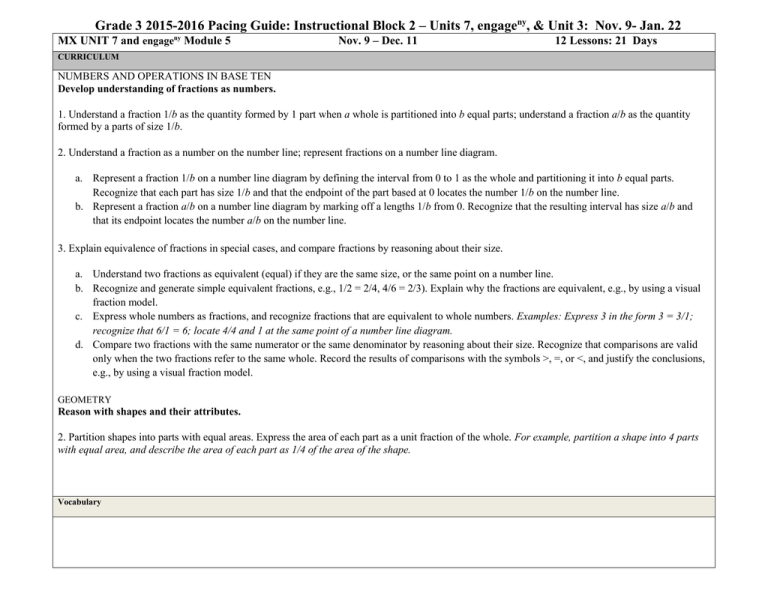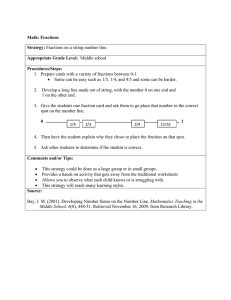Grade 3 Pacing Guide Block 2 Unit 7
advertisement

Grade 3 2015-2016 Pacing Guide: Instructional Block 2 – Units 7, engageny, & Unit 3: Nov. 9- Jan. 22 MX UNIT 7 and engageny Module 5 Nov. 9 – Dec. 11 12 Lessons: 21 Days CURRICULUM NUMBERS AND OPERATIONS IN BASE TEN BERS AND OPERATIONS – FRACTIONS Develop understanding of fractions as numbers. 1. Understand a fraction 1/b as the quantity formed by 1 part when a whole is partitioned into b equal parts; understand a fraction a/b as the quantity formed by a parts of size 1/b. 2. Understand a fraction as a number on the number line; represent fractions on a number line diagram. a. Represent a fraction 1/b on a number line diagram by defining the interval from 0 to 1 as the whole and partitioning it into b equal parts. Recognize that each part has size 1/b and that the endpoint of the part based at 0 locates the number 1/b on the number line. b. Represent a fraction a/b on a number line diagram by marking off a lengths 1/b from 0. Recognize that the resulting interval has size a/b and that its endpoint locates the number a/b on the number line. 3. Explain equivalence of fractions in special cases, and compare fractions by reasoning about their size. a. Understand two fractions as equivalent (equal) if they are the same size, or the same point on a number line. b. Recognize and generate simple equivalent fractions, e.g., 1/2 = 2/4, 4/6 = 2/3). Explain why the fractions are equivalent, e.g., by using a visual fraction model. c. Express whole numbers as fractions, and recognize fractions that are equivalent to whole numbers. Examples: Express 3 in the form 3 = 3/1; recognize that 6/1 = 6; locate 4/4 and 1 at the same point of a number line diagram. d. Compare two fractions with the same numerator or the same denominator by reasoning about their size. Recognize that comparisons are valid only when the two fractions refer to the same whole. Record the results of comparisons with the symbols >, =, or <, and justify the conclusions, e.g., by using a visual fraction model. GEOMETRY Reason with shapes and their attributes. 2. Partition shapes into parts with equal areas. Express the area of each part as a unit fraction of the whole. For example, partition a shape into 4 parts with equal area, and describe the area of each part as 1/4 of the area of the shape. Vocabulary Models Strategies Instruction: Unit 7 Explore Fractions and engageny Assessment Lessons 1 – 5 Fraction Concepts Lessons 6 - 9 Equivalent Fractions engageny Module 5 Fractions as Numbers on the Number Line Lesson 8: Represent part of one whole as fractions with number bonds Lesson 16: Place whole number fractions and fractions between whole numbers on the number line Lesson 22: Generate simple equivalent fractions by using visual fraction models and the number line Quick Quiz 1 Quick Quiz 2 *Block 5 includes more of engageny Module 5. Based on student needs, you may include more of these lessons during this block. ST MATH – Fraction Concepts, Fractions on the Number Line MX Unit 7 Performance Assessment MX Unit 7 Performance Task MX Unit 7 Unit Test


